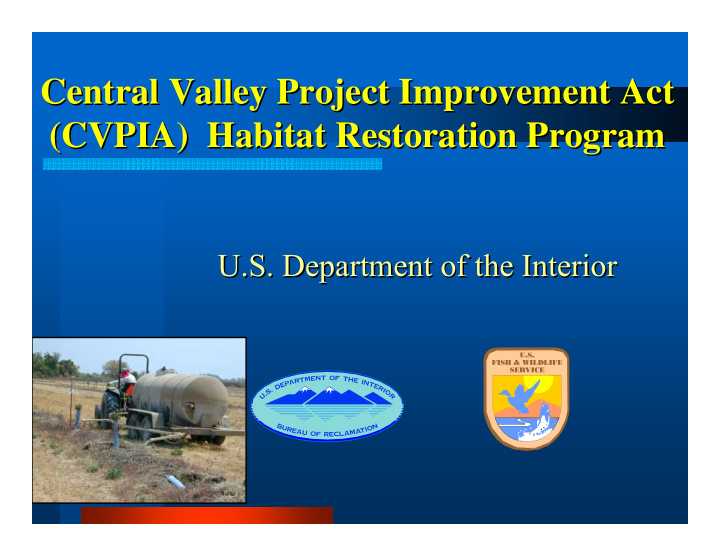



Central Valley Project Improvement Act Central Valley Project Improvement Act (CVPIA) Habitat Restoration Program (CVPIA) Habitat Restoration Program U.S. Department of the Interior U.S. Department of the Interior
Management of the HRP Management of the HRP Co-Managers John Thomson BOR Caroline Prose FWS
Section 3406(b)(1) “other” Section 3406(b)(1) “other” Habitat Restoration Program Habitat Restoration Program � “…in the course of developing and implementing this program the Secretary shall make all reasonable efforts consistent with the requirements of this section to address other identified adverse environmental impacts of the CVP not specifically enumerated in this section.”
Objectives of HRP Objectives of HRP � Protect and restore native habitats impacted by CVP. � Stabilize and improve populations of native species impacted by CVP. Initial focus is on listed species. � Minimize conflicts with current and ongoing CVP projects and programs. � Effectively coordinate with Bay-Delta Authority Ecosystem Restoration Strategy
Technical Team Technical Team � Bureau of Reclamation � Fish and Wildlife Service � California Department of Fish and Game
Proposal Selection Criteria Proposal Selection Criteria � CVP nexus � Program priority � Listed species baseline benefits � Species endangerment � Proposed/candidate species benefits � Target species (federal species of concern) � State listed species � Ecosystem or multiple species benefits
Proposal Selection Criteria Proposal Selection Criteria (cont…) (cont…) � Cumulative & long-term benefits � Project connectivity � Partnerships � Enhancement of biodiversity � Level of CVP-related impacts � Cost effectiveness � Immediacy (degree of imminent threat to habitats and species)
Current Program Priorities Current Program Priorities � Reflect the most current evaluation of species needs and habitat trends � Are complimentary to other ongoing actions within the Central Valley � Take into account historical levels of investment and future threats to specific ecosystems � Six current priorities identified
Priority #1: Serpentine and other unique topo-edaphic [area relating to soils] habitats supporting endemic species, such as the bay checkerspot butterfly, in Santa Clara County. Serpentine soils plants on Coyote Ridge
Bay checkerspot butterfly (FT)
Need photos of Santa Clara Valley dudleya, Metcalf Canyon jewelflower, and/or “most beautiful” jewelflower. Santa Clara Valley dudleya (FE)
“Most beautiful” jewelflower (FSC)
Priority 2: Grassland, alkali sink, and alkali scrub in Central Valley, with emphasis on the Tulare Basin, and on habitat linkages for the SJ kit fox, blunt-nosed leopard lizard, Tipton kangaroo rat, etc. Alkali scrub habitat
Alkali scrub habitat
San Joaquin kit fox (FE, ST)
Blunt-nosed leopard lizard (FE)
Palmate-bracted bird’s beak (FE)
Priority #3: Vernal pool habitat throughout Central Valley supporting the California tiger salamander, listed vernal pool invertebrates, and listed plant species.
� ADD CA TIGER SALAMANDER PHOTO HERE California tiger salamander (FT)
� ADD FAIRY SHRIMP PHOTO HERE Vernal pool fairy shrimp (FT)
� ADD FLESHY OWL’S CLOVERHERE Fleshy owl’s clover (FT) Slender orcutt grass (FT)
Priority #4: Riparian upland habitat mosaic throughout southern Central Valley (Tulare, Kern, Madera, Merced, Fresno, and Kings counties), supporting species such as giant garter snake, riparian brush rabbit, California red-legged frog, etc.
Giant garter snake (FT)
Riparian brush rabbit (FE)
California red-legged frog (FT)
Priority #5: Habitat protection and management of gabbro soils chaparral habitat in El Dorado County, supporting federally listed plant species, with special emphasis in the southern region of the Pine Hills Preserve. Gabbro soils chaparral habitat
� ADD GABBRO SOIL PLANT SPECIES HERE Stebbins morning glory (FE)
Pine Hill ceanothus (FE)
Pine Hill flannelbush (FE)
Priority #6: Oak woodland habitats found in association with other habitat types discussed above and in the Central Valley. Oak woodland
Oak woodland
Implementation Activities Implementation Activities � Acquisition � Conservation Easement � Habitat Restoration � Habitat Management � Captive Breeding/Reintroduction � Studies � Monitoring
Accomplishments to Date Accomplishments to Date � Initiated in FY 1996 Project funding to date: $19.5 million � Currently funded @ $1.5 million/year � � Funded 67 projects since 1996 � ~98,000 acres protected (fee title or conservation easement) � Contributed funding towards six riparian restoration projects (~600 acres) � Provided primary funding ($1 million) for riparian brush rabbit captive breeding/reintroduction program � Funded five management/planning actions related to acquisition/restoration projects � Funded eighteen surveys/studies addressing listed species impacted by the CVP
Projects Funded in FY 2004 Projects Funded in FY 2004 Giant Garter Snake Surveys at Colusa NWR $88,619 Giant Garter Snake Surveys at SLNWR 135,259 Giant Garter Snake Surveys at Grasslands EA 102,620 Adaptive Vegetation Mgt on Serpentine Soils 32,300 Ohm Property Riparian Restoration 62,500 Drumheller Slough Riparian Restoration 325,000 Ansin Property Acquisition in Carrizo Plain 541,000 Fine Gold Creek Acquisition 350,000 Joint Venture GIS Web Page 31,000 Program Administration 276,702 Total = $1.945 million* *includes $445,000 from prior year’s funds
Preliminary Project Funding for Preliminary Project Funding for FY 2005 FY 2005 Giant Garter Snake Surveys at Colusa NWR $114,280 Adaptive Vegetation Mgt on Serpentine Soils 64,800 Sno-bird unit Merced NWR, Vernal Pool Restoration 88,676 SacNWR, Vernal Pool, Alkali Wetlands Restoration 93,524 Kern County, Carrizo Plain Land Acquisition (BLM) 400,000 CA Red-legged Frog Surveys in Placer/El Dorado Co 45,137 Vernal Pool Plant Association Study in Central Valley 163,867 Herbert Preserve, Restoration & Adaptive Management 346,861 Dos Rios Ranch, Working Landscape Conservation Easement 144,334 Program Administration 209,094 Total = $1,670,573* *includes $170,573 from prior year’s funds
Future Goals of the HRP Future Goals of the HRP ■ Continue current funding level of $1.5 million annually. ■ Continue on-going prioritization of species and actions targeted by the HRP. ■ Expand outreach and coordination. ■ Establish “measurable outcomes” related to past and future actions. � Identify habitat and species “mitigation” goals related to “other” CVP impacts. � Summarize previous restoration efforts. � Implement restoration in areas not previously restored. ■ Continue funding and implementation of effective project actions.
Partnerships Partnerships � We are more effective working together than working individually BOR TNC UCD FWS TPL CSUC USFS ARC CDFG NRCS NFWF WCB BLM CALFED
Recommend
More recommend